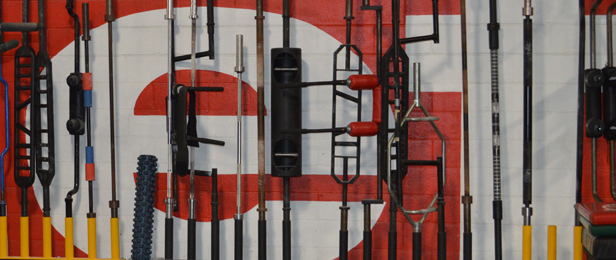
With all the specialty bars that elitefts™ offers, it can get a little confusing as to their purpose and usefulness. Let me help just a little by explaining the use of a few of them at Team Samson Powerlifting.
We incorporate two of the specialty bars from elitefts™ into our regular training cycle; the Cambered Bar and the Safety Squat Yoke Bar™.
Before I get into the specific use for each of these bars I want to explain why we use them in our training cycles.
1. We sometimes don’t like to admit this one because it puts a chip in our hardcore training persona's, but training can get redundant. Training can get boring. Straight bar squatting week-in and week-out can get to us. I’ve been weight training for 16 years and I have found that I don’t always run through the door of the gym foaming at the mouth to get under the bar. Sometimes I need to change the movements to keep me motivated. That’s where the specialty bars come in.
2. The specialty bars give us a chance to heal over-used joints and muscles. For a few years I had elbow pain that prevented me from PRing on the bench. Sometimes it was bad enough to prevent me from doing everyday things like yard work or taking the trash out. They were always trashed. The specialty bars helped me keep the weight off my arms without giving up the squat altogether. Along with some other rehabbing, the extra rest allowed me to heal up.
3. And finally, the specialty bars help us address certain weaknesses. I’ll address this more when I address what each of the bars do.
So for these reasons, they play a role, an important role, and shouldn’t be overlooked.
The *Safety Squat Yoke Bar™:
The *SS Yoke Bar™ will play an important role for you guys who are experiencing shoulder issues from heavy benching. Getting your arms under a squat puts the shoulders under a lot of stress that can prevent bench PRs from rolling around as quickly. It also provides much needed rest for the arms that take a beating during a heavy training cycle when both the squat and bench are being pushed hard. With the SSB you can just let the yoke sit on your traps with your hands on the yoke extensions, virtually taking the arms from the shoulders down completely out of the lift.
The SSB will also address lower back weaknesses. The positioning of the weight will try to force the lifter forward causing more stress on the lumbar region. It will also help a lifter identify the feeling of sitting back as they will be forced to do so in order to keep proper form. You can increase that by using a box. Remember to keep your upper back tight and your head high. The head is important because you will find it a little harder to do with the yoke wrapped around your neck.
Just a warning, and this will apply to both bars, don’t spend too many consecutive sessions with any one specialty bar. Once you have mastered the bar, its effectiveness can diminish. I have also found that bad habits may arise, making the transition back to the straight bar more difficult than it needs to be. Therefore, I try not spending more than three weeks on any one specialty bar.
The Rackable Cambered Squat Bar:
The Rackable Cambered Squat Bar is a more recent addition. I really like it. Over the last few months it has become my second favorite movement behind the straight bar squat.
Like the SSB, the Rackable Cambered Squat Bar takes the stress off the arms allowing the lifter to hit big weights while leaving something in the tank for the bench. I simply lay my arms over the lower bar and allow them to rest there—no stress on them at all.
If you have stability issues, this is the bar that will help you correct them. Sometimes we get so used to one movement that we over develop the muscles involved and leave lesser involved muscles under-developed. Issues like that generally wait for the really heavy weight to pop up and we are left wondering what went wrong. Why did we get so loose? Why couldn’t I get that weight completely in position? The questions could go on, but the answer is usually the same—there are weaker and underdeveloped muscles somewhere in the chain.
The positioning of the weight on the Rackable Cambered Squat Bar allows it to move around quite a bit; this forces you to use muscles not used during a straight bar squat. Developing these muscles will allow the lifter to move the heavier weight with a greater degree of accuracy as far as their form goes. Throw some chains in the mix and look out, the level of difficulty will rise tremendously.
As with the SSB, there are bad habits that will form with overuse of this bar, so rotate it in and out of training cycles.








